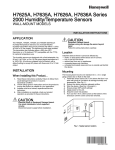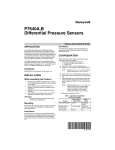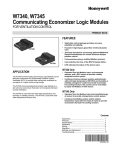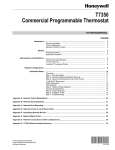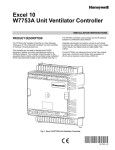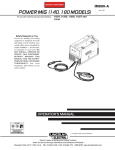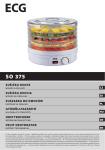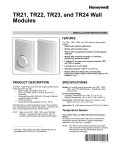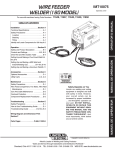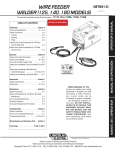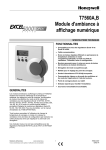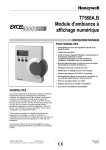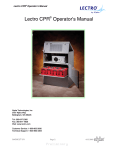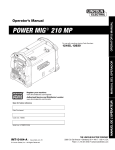Download Honeywell H7625B User's Manual
Transcript
H7625B; H7635B,C; H7655B Duct-Mount and Outdoor-Mount Humidity/Temperature Sensors INSTALLATION INSTRUCTIONS APPLICATION The H7625B, H7635B, H7655B Duct-Mount and H7635C Outdoor-Mount Humidity/Temperature Sensors are universal Relative Humidity transmitters that can be powered with either a +18 to 36 Vdc or 24 Vac supply. The sensors use a half-wave bridge rectifier to convert AC power to a usable DC voltage. The device also includes a 20K ohm temperature sensor for optional use. The humidity sensors are designed with a fieldselectable 4 to 20 mA, 0 to 5 Vdc, or 0 to 10 Vdc output signal equivalent to 0 to 100% RH. All units are shipped from the factory with a default setting to accept AC power with three-wire, 0 to 10 Vdc loop-powered output. INSTALLATION Mounting The method of mounting depends on the particular sensor application. The following procedures include outdoor and duct applications. Also refer to the instructions for the electronic control. Duct Mounting The H7625B, H7635B and H7655B can be mounted in a duct to sense humidity and temperature. IMPORTANT Select a location to expose sensor to average duct humidity and temperature. Avoid locations where stratification can cause sensing errors. NOTES: — When Installing this Product... 1. 2. 3. 4. Read these instructions carefully. Failure to follow them could damage the product or cause a hazardous condition. Check ratings given in instructions and on the product to ensure the product is suitable for your application. Installer must be a trained, experienced service technician. After installation is complete, check out product operation as provided in these instructions. 1. 2. 3. 4. 5. 6. NOTE: The two free wires are thermistor wiring connections. When connecting these, use two wire nuts. CAUTION Electrical Shock or Equipment Damage Hazard. Can shock individuals or short equipment circuitry. Disconnect power supply before installation. H7635C is weatherproof for outdoor use. Knockouts allow 1/2 in. conduit connection. — To avoid damaging board during installation, the cover can be detached completely: 1.Carefully remove wire plug from board. 2.Set the cover aside. Cut a hole in the duct just large enough to accept the sensing element. Open case by rotating the cover counterclockwise. Mount standard 1/2 in. conduit to the case. Use case to mark mounting screw pilot hole locations. Drill the pilot holes and fasten the sensor to the duct. Wire the sensor. See Wiring section. 7. Reattach the wire plug and cover being careful not to pinch wires between the cover and case. CAUTION Equipment Damage Hazard. Improper wiring can damage the sensor beyond repair. Follow the wiring instructions carefully. 63-2579—3 H7625B; H7635B,C; H7655B DUCT-MOUNT AND OUTDOOR-MOUNT HUMIDITY/TEMPERATURE SENSORS Outdoor Mounting The H7635C senses outdoor air humidity and temperature. Mount this control where it can sense average outdoor air humidity and temperature. Normally, the north side of a building provides a suitable location. NOTES: — — 1. H7635C is weatherproof for outdoor use. Knockouts allow 1/2 in. conduit connection. To avoid damaging board during installation, the cover can be detached completely: 1.Carefully remove wire plug from board. 2.Set the cover aside. Open case by rotating the cover counterclockwise. Output Settings (Table 1) The board has three switch blocks: — A six DIP switch block. — A four DIP switch block. — A white gang switch on a blue block. 1. Adjust the 4-switch block according to Table 1. NOTE: The 6-switch block normally requires no adjustment. (See the Appendix.) 2. Set the gang switch (white switch in blue block) to correspond with the output (mA or Vdc). NOTE: See Fig. 1 for DIP switch locations. Table 1. Controller Compatibility and Output Settings. NOTE: Orient case so the element points down. 2. 3. 4. 5. 6. 7. Required 4-Switch Block Blue and Sensor Settings White Output Output LONSPEC™ Setting Setting 4 3 2 1 Switch Mount standard 1/2 in. conduit to the case. Use case to mark mounting screw pilot hole locations. Drill pilot holes. Fasten the case to the wall. Wire the sensor. See Wiring section. W7750, W7760, 4-20 mA — On — — 4-20 mA C7600C W7761 NOTE: The two free wires are thermistor wiring connections. When connecting these, use two wire nuts. W7750B,C 0-10 Vdc On — — On Vout W7760C, (default) W7753, W7760 H7621/31 T7350, XL50, XL100, XL500 XF Modules, XFL n/a Reattach the wire plug and cover being careful not to pinch wires between the cover and case. Controller 0-10 Vdc On — — On Vout (default) Non-Honeywell 0-5 Vdc On — On — Vout n/a OFF ON 0-10 VDC NORMAL OPERATION OFF OFF ON ON 4-20 MA OFF ON 0-5 VDC M22705 Fig. 1. DIP switch locations and settings. 63-2579—3 2 H7625B; H7635B,C; H7655B DUCT-MOUNT AND OUTDOOR-MOUNT HUMIDITY/TEMPERATURE SENSORS WIRING For voltage output, shielded cable (16-22 AWG) should be used. mA OUTPUT TRANSDUCER ONLY For current output, either shielded cable or twisted pair (16-22 AWG) can be used. NOTE: When using shielded cable, ground the shield only at the controller end (see Fig. 2). Grounding both ends can cause a ground loop. 18 TO 36 Vdc POWER SUPPLY Vin + Io – CONTROLLER, METER OR RECORDER + INPUT SIGNAL – COMMON The 20K ohm NTC temperature output is accessed through the separate blue and green wires (located inside the enclosure). GROUND M22528 Fig. 2. Typical wiring diagram for transducer with twowire mA output and external DC power supply. OUTDOOR AIR SENSOR T7770 REMOTE SENSOR 9 T7350 SUBBASE 8 7 T5 6 T6 5 4 T7 3 2 DISCHARGE AIR SENSOR 1 T4 HEAT RELAY 2 T3 OS OS AS AS HP M M X RH COMPRESSOR CONTACTOR 4 W3/Y4 Y3 COMPRESSOR CONTACTOR 2 W2 Y2 Y1 G 5 HS HC RC AUX W1 COMPRESSOR CONTACTOR 3 Vo Gnd Vin (0-10 Vdc) (Vac) 3 MOTION SENSOR HEAT RELAY 1 HUMIDITY SENSOR 4 1 2 FAN RELAY COMPRESSOR CONTACTOR 1 ECONOMIZER L2 L1 (HOT) 1 POWER SUPPLY. PROVIDE DISCONNECT MEANS AND OVERLOAD PROTECTION AS REQUIRED. 2 ENSURE TRANSFORMER IS SIZED TO HANDLE THE LOAD. 3 HEAT/COOL SYSTEMS WITH ONE TRANSFORMER REQUIRE THE FACTORY-INSTALLED JUMPER. 4 USE ECONOMIZER INSTRUCTIONS FOR INSTALLATION DIRECTIONS. 5 HC AND HP PROVIDE 24 VAC TO THE HUMIDITY SENSOR. M22529 Fig. 3. Humidity sensor (0-10 Vdc output) wiring with T7350 (use with RH/Temperature combination T7350 units only). 3 63-2579—3 H7625B; H7635B,C; H7655B DUCT-MOUNT AND OUTDOOR-MOUNT HUMIDITY/TEMPERATURE SENSORS P7640 + – + – COM O OUT COM 19 20 21 22 23 + – Vin (Vac) Gnd 2 O Vo (0-10 Vdc) O OUT 1 2 3 4 5 6 7 8 9 10 11 12 13 E GND AI 1 AI 2 AI GND AI 3 AI 4 AI GND AI 5 AI 6 AI GND AI 7 AI 8 AI GND DI 1 DI 2 DI 3 DI 4 25 26 27 28 OUT OUT OUT OUT OUT OUT OUT OUT 1 2 3 4 5 6 7 8 18 + – PWR W7760A 17 H76XX P7640 PWR 24 1 GND GND 15 16 ANALOG OUT AO AO 1 2 14 AO GND 24 24 24 24 24 24 24 OUT 21 GND VAC VAC VAC VAC VAC VAC VAC COM VDC COM COM OUT 29 31 32 33 34 35 36 37 38 39 40 E-BUS 41 42 E-BUS 43 L1 (HOT) L2 1 POWER SUPPLY. PROVIDE DISCONNECT MEANS AND OVERLOAD PROTECTION AS REQUIRED. 2 TEMPERATURE SIGNAL CONNECTIONS ARE NOT POLARITY SENSITIVE. M18302B Fig. 4. Typical wiring diagram for 5-wire temperature/humidity sensor with Vdc output (used with the XL15A controller). 63-2579—3 4 44 H7625B; H7635B,C; H7655B DUCT-MOUNT AND OUTDOOR-MOUNT HUMIDITY/TEMPERATURE SENSORS CHECKOUT Converting Output Signal to Percent RH CAUTION Equipment Damage Hazard. Can short electric circuitry. • Never connect 120 Vac to the transducer. • Connect only DC voltage to a transducer intended for DC supply. NOTE: Use laboratory quality meters and gauges for applications requiring a high degree of accuracy. 1. 2. 3. Verify the transducer is mounted in the correct position. Verify appropriate input signal and voltage supply. Verify appropriate configuration range. 4 to 20mA Signal 〈 signal [in mA] – 4〉 ------------------------------------------------- = percent RH 0.16 Example: 12 mA output signal (12 - 4)/ 0.16 = 50% RH 0 to 10 Vdc Signal Example: 8 VDC transmitter signal output 8 Vdc/0.10 = 80% RH Table 2. Troubleshooting. Problem Items to Check No reading • Verify correct supply voltage at the power terminal blocks. • Verify correct wiring configuration and DIP switch settings. • Verify that terminal screws are connected tightly with all wires firmly in place. Erratic readings • Verify all wires are terminated properly. • Ensure that there is no condensation on the board. • Verify clean input power. In areas of high RF interference or noise, shielded cable can be necessary to stabilize signal. 5 63-2579—3 H7625B; H7635B,C; H7655B DUCT-MOUNT AND OUTDOOR-MOUNT HUMIDITY/TEMPERATURE SENSORS APPENDIX RH Test and Configuration DIP Switch Settings (Table 3) IMPORTANT • Only adjust these switches for troubleshooting or recalibrating the sensor. (Adjustment is not normally necessary.) • For normal operation, always keep DIP switch 3 in the ON position. When DIP switch 3 is off, the RH transmitter cannot read the sensor. This inability-to-read forces the output to never change. Table 3. Test/Calibration Settings (Six-Switch Block). Setting Normal Operation (Default) 6 5 4 3 2 1 — — — On — — 0% RH Output On — — — — — 50% RH Output — On — — — — 100% RH Output — — On — — — Increment RH Output — — — — On — Decrement RH Output — — — — — On Reset to Original Calibration — — — — On On 63-2579—3 0% RH Output (for Testing Only) Transmitter always outputs a signal of 4 mA or 0 Vdc. The sensor does not affect the transmitter output. 50% RH Output (for Testing Only) Transmitter always outputs a signal of 12 mA, 2.5 VDC, or 5 VDC. The sensor does not affect transmitter output. 100% RH Output Transmitter always outputs a signal of 20 mA, 5 VDC, or 10 VDC. The sensor does not affect the transmitter output. Sensor doesn’t affect the transmitter output. Normal Operating Condition DIP switch 3 must be set in the On position for normal operation. All other DIP switches must be set Off. 6 H7625B; H7635B,C; H7655B DUCT-MOUNT AND OUTDOOR-MOUNT HUMIDITY/TEMPERATURE SENSORS CALIBRATION All transducers are factory calibrated to meet/exceed published specifications. Field adjustment should not be necessary. IMPORTANT • Do not verify comparative RH with a sling psychrometer. Too many variables exist which induce errors into this process. • Recalibration must be done in a controlled environment. Relative humidity must be held stable while making any adjustment. • Verify the device output directly with calibrated instrumentation and verify RH with calibrated instrumentation. Never use a controller output. • With correct power applied, and only a meter connected to the transducer output, ensure that the output is proportional to the true RH. Using Increment/Decrement Switches Increment RH Output This DIP switch allows you to calibrate the sensor through the software. The switch must be toggled from the Off to the On position and then returned to the Off position for an increase of 0.5% RH. This means that if your humidity has drifted 1% lower over a certain time period, you can toggle the Increment RH Output switch (2 times) in order to slide the whole curve upward 1%. Decrement RH Output This DIP switch allows calibration in the same way as the Increment RH. The difference is that each toggle results in a decrease of 0.5% RH. Using Calibration Trim Potentiometers IMPORTANT • Due to sensitive nature of humidity calibration, adjusting trimmer potentiometers is not highly recommended. • Calibrate only in a stable humidity/temperature chamber of laboratory grade. Single Point Calibration IMPORTANT Use only one of the following two options. OPTION 1 1. Select a controlled humidity environment between 10 and 40 percent RH. Be sure humidity is stable. 2. Adjust zero trimmer (z). OPTION 2 1. Select a controlled humidity environment between 40 and 70 percent RH. Be sure humidity is stable. 2. Adjust span trimmer (s). Two Point Calibration 1. Select a controlled humidity environment between 10 and 40 percent RH. Be sure humidity is stable. 2. Adjust zero trimmer (z). 3. Select a controlled humidity environment between 70 and 75 percent RH. Be sure humidity is stable. 4. Adjust span trimmer (s). 7 63-2579—3 LonSpec™ is a trademark of Echelon® Corporation. Automation and Control Solutions Honeywell International Inc. Honeywell Limited-Honeywell Limitée 1985 Douglas Drive North 35 Dynamic Drive Golden Valley, MN 55422 Scarborough, Ontario M1V 4Z9 customer.honeywell.com ® U.S. Registered Trademark © 2005 Honeywell International Inc. 63-2579—3 B.B. Rev. 01-05








